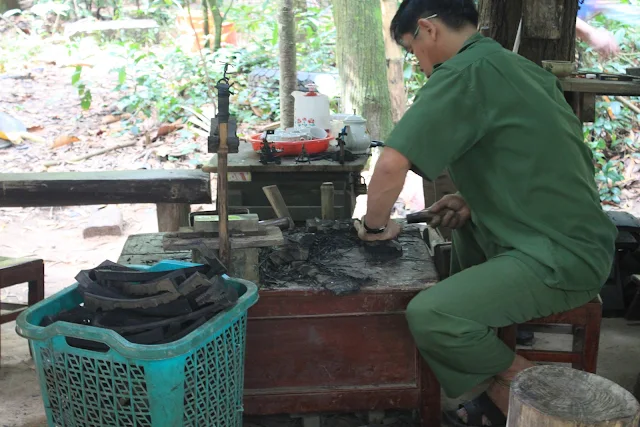Kindly Yours - A collection of writings, thoughts and images. This blog does contain third party weblinks. No AI content is used.
Monday, 17 December 2012
Cu Chi Tunnels - Vietnam
The cu chi is a fruit, but less well known as the tunnels named after them on the outskirts of Ho Chi Minh City in Vietnam. When the city was officially called Saigon, the tunnels were a labyrinth of physical access, supply routes and community living intentionally hidden from society on the surface, as they housed the Vietcong, with which US forces and the South Vietnamese army engaged militarily, in the many years of the war in the sixties and early seventies of the 20th century, now referred to as the Reunification War. An underground network, the tunnels played a pivotal role to successfully turn the tide of victory for Ha Noi - and was especially critical in the Tet offensive of 1968 on Saigon city itself. Today the forested area caters to tourists, local and foreign, to echo the harsh and challenging life of the soldier fighting on the side of their leader, Ho Chi Minh. The tunnels, with air shafts, were used to connect spaces storing weapon caches, those serving as secret field hospitals and corners utilised as kitchens and living quarters. The nature of the environment with such narrow tunnels nurtured the spread of malaria. Above photo captures a present day army cobbler making leather foot gear as was practised during wartime.
Remnants and reminders of the American military involvement can easily be seen in dilapidated tanks
displayed on site (picture above) and in huge craters resulting form the carpet bombing of the area by B52 bombers. A visit to the tunnels today does not reveal the extent of rats, spiders, centipedes, scorpions and ants that infest such accommodation. Our guide reminded us that the original tunnels were much narrower than what is existing today. I did not go beyond the first stage of the four phased tunnel climb earmarked for tourists. On coming out of the tunnels, we washed our hands, legs and elbows on a trough with water flowing from a makeshift pipe system. From Saigon city centre, it easily took travelling of around 70 kilometres to reach the tunnels.
Visitors can take quiet paced strolls under the canopy of the tropical forest (above), or try their skills in a shooting range and even observe chickens in a placid village-like setting (photo below). Such calm experiences does not fully reveal the extent of conflict and violence raging on the same grounds a half century ago. I did wonder how the area would look and feel like on a wet rainy day. Would the water run into the tunnels, or the drainage has been designed well enough to prevent flooding underground? We were given rough and ready yam snacks to remind us of the lifestyle for those living in the Cu Chi Tunnels during wartime. Our guide, Mr Hye, also gave a talk to accompany a Government issued movie in a make shift hall on premises.
The Cu Chi Tunnels were laden with punji stake pits and vicious forms of booby traps for the unsuspecting soldier from the other side. It was an Australian specialist engineering troop (known as 3 Fd Tp) which discovered and realised the significance of the tunnels and passed that information to the American forces. Grenades were thrown into the tunnel entrances to flush out any hiding forces from the enemy side. The dexterity and passion of the individuals living in such tunnels for a personal belief and cause cannot be under estimated.
Subscribe to:
Post Comments (Atom)
Will It Still Matter?
Will it matter, after all is said and done? The hydrangea shrub has its leaves and stems roasted after three days of extraordinary temperat...
-
Haha, I do not mean to frighten any one at all with a close up shot of well marinated chicken feet , prepared ala Cantonese sty...
-
More than memories of backpacking - aromatic briyani rice on a rectangle sized banana leaf ala natural plate, accompanied by (clockwis...
-
The Obvious Cannot be Hidden by the Silence, the Silence Cannot be Hidden by the Obvious. Every detail, every sweep and every nook are so c...










No comments:
Post a Comment